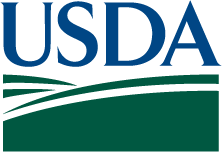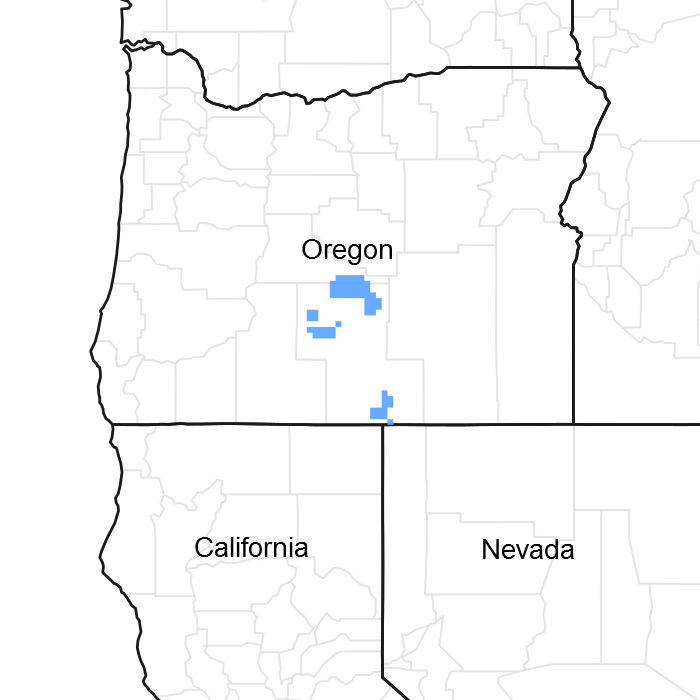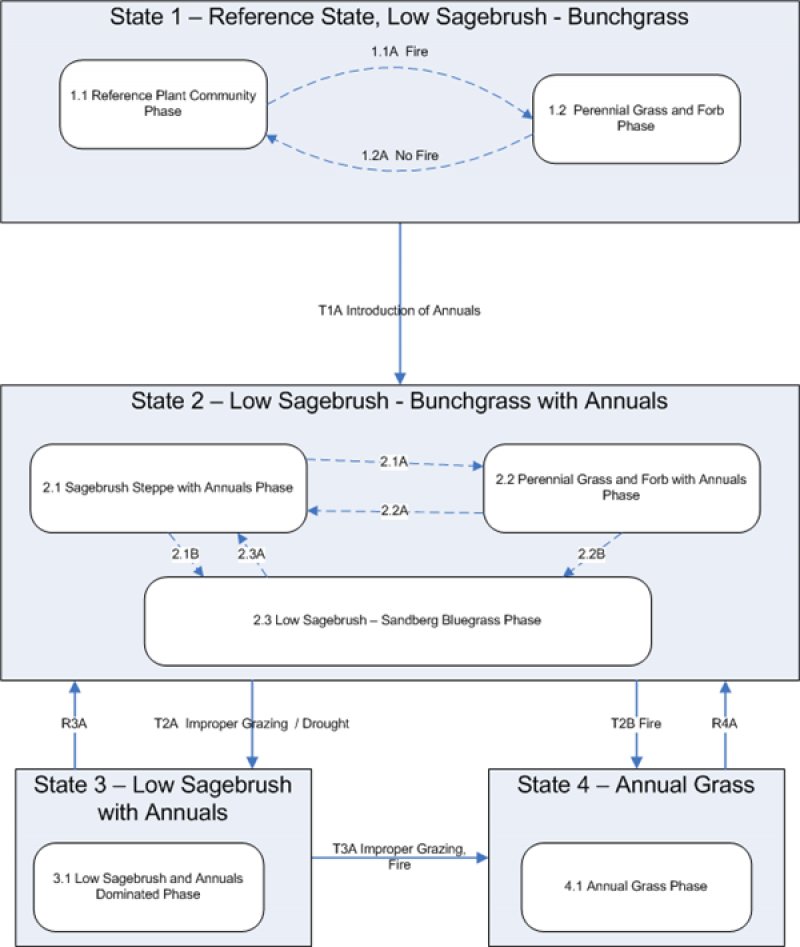
Natural Resources
Conservation Service
Ecological site R023XY511OR
JUNIPER LAVA BENCHES 9-12 PZ
Accessed: 12/06/2025
General information
Provisional. A provisional ecological site description has undergone quality control and quality assurance review. It contains a working state and transition model and enough information to identify the ecological site.

Figure 1. Mapped extent
Areas shown in blue indicate the maximum mapped extent of this ecological site. Other ecological sites likely occur within the highlighted areas. It is also possible for this ecological site to occur outside of highlighted areas if detailed soil survey has not been completed or recently updated.
Table 1. Dominant plant species
| Tree |
(1) Juniperus occidentalis |
|---|---|
| Shrub |
(1) Artemisia arbuscula ssp. arbuscula |
| Herbaceous |
(1) Festuca idahoensis |
Physiographic features
This site occurs on lava plateaus and gentle slopes.
Table 2. Representative physiographic features
| Landforms |
(1)
Plateau
|
|---|---|
| Flooding frequency | None |
| Ponding frequency | None |
| Elevation | 1,219 – 1,676 m |
| Slope | 0 – 15% |
| Aspect | Aspect is not a significant factor |
Climatic features
Most of the annual precipitation occurs during the months of October through March. The mean annual air temperature is 44 degrees F. Temperature extremes range from 110 to -30 degrees F. The soil temperature regime is frigid. The period for optimum plant growth is from April through early June.
Table 3. Representative climatic features
| Frost-free period (average) | 120 days |
|---|---|
| Freeze-free period (average) | 80 days |
| Precipitation total (average) | 305 mm |
Figure 2. Monthly average minimum and maximum temperature
Influencing water features
Soil features
The soils of this site are shallow and well drained. They have a course-textured surface and fine-textured subsoils, and may have stones or cobbles on the surface. They are generally composed of volcanic ash over residuum or colluvium from basalt or tuff. Permeability is moderately slow and the available water holding capacity is 2-6 inches for the profile. The potential for water or wind erosion is high.
Table 4. Representative soil features
| Parent material |
(1)
Residuum
–
basalt
|
|---|---|
| Surface texture |
(1) Very gravelly sandy loam (2) Stony |
| Family particle size |
(1) Loamy |
| Drainage class | Well drained |
| Permeability class | Slow to moderately rapid |
| Soil depth | 33 – 76 cm |
| Surface fragment cover <=3" | 5 – 30% |
| Surface fragment cover >3" | 0 – 25% |
| Available water capacity (0-101.6cm) |
6.35 – 15.75 cm |
| Calcium carbonate equivalent (0-101.6cm) |
0% |
| Electrical conductivity (0-101.6cm) |
0 mmhos/cm |
| Sodium adsorption ratio (0-101.6cm) |
0 |
| Soil reaction (1:1 water) (0-101.6cm) |
6.6 – 7.8 |
| Subsurface fragment volume <=3" (Depth not specified) |
4 – 7% |
| Subsurface fragment volume >3" (Depth not specified) |
1 – 10% |
Ecological dynamics
Range in characteristics:
The reference native plant community is dominated by western juniper, low sagebrush, and Idaho fescue. Sandberg bluegrass is common along with minor occurrences of Thurber needlegrass and bluebunch wheatgrass. Vegetative composition is approximately 70% grasses, 10% forbs, and 20% trees and shrubs.
Four states have been identified for this site: a reference state; a state with the presence of annuals; a state that has juniper and low sagebrush co-dominant on the site, and a state with annual dominance.
Reference State: Stable plant community affected infrequently by fire. Sites are dominated with low sagebrush with some sites exhibiting a small percentage of old growth juniper. Infrequent fire (> 80 to 100 year intervals) maintained site dynamics. Fire reduces shrub cover in a mosaic, patchy pattern. The introduction of invasive annual grasses and forbs transitions into state 2.
State 2: Compositionally similar to the reference state with a trace of cheatgrass and/or medusahead and other annual weeds. Ecological function has not changed, however the resiliency of the state has been reduced by the presence of invasive weeds. Infrequent fire (> 80 to 100 years) reduces shrub cover, removes young juniper and promotes grass production while time since fire allows shrub recovery. Mismanagement of grazing facilitates an increase in Sandberg bluegrass, weedy species, young juniper, and low sagebrush. Moderately-deep rooted bunchgrasses decline in production and density. Prescribed grazing can reverse the trend. Loss of deep-rooted perennial bunchgrasses and an increase in young juniper brings the site to State 3.
State 3: Low sagebrush and possibly young juniper dominated with minimal perennial, moderately-deep rooted bunchgrasses. Cheatgrass and/or medusahead along with other weedy forbs are increased in density and cover. Sandberg bluegrass cover and vigor is declining. Water flow paths are evident. Sagebrush, and possibly juniper, control site resources. Catastrophic wildfire leading to annual dominated plant community will take the site to State 4.
State 4: Cheatgrass and/or medusahead dominated. A few old growth juniper may be present. Rabbitbrush increased with few to no low sagebrush. Wind and water erosion drive site processes.
State and transition model

Figure 3. Group 10, STM
More interactive model formats are also available.
View Interactive Models
More interactive model formats are also available.
View Interactive Models
Click on state and transition labels to scroll to the respective text
Ecosystem states
State 1 submodel, plant communities
State 1
Reference State
Community 1.1
Reference Plant Community
Figure 4. Annual production by plant type (representative values) or group (midpoint values)
Table 5. Annual production by plant type
| Plant type | Low (kg/hectare) |
Representative value (kg/hectare) |
High (kg/hectare) |
|---|---|---|---|
| Grass/Grasslike | 392 | 549 | 706 |
| Shrub/Vine | 56 | 78 | 101 |
| Tree | 56 | 78 | 101 |
| Forb | 56 | 78 | 101 |
| Total | 560 | 783 | 1009 |
Additional community tables
Table 6. Community 1.1 plant community composition
| Group | Common name | Symbol | Scientific name | Annual production (kg/hectare) | Foliar cover (%) | |
|---|---|---|---|---|---|---|
|
Grass/Grasslike
|
||||||
| 1 | Perennial, moderately-deep rooted, bunchgrass | 353–432 | ||||
| Idaho fescue | FEID | Festuca idahoensis | 353–432 | – | ||
| 2 | Perennial, shallow rooted, bunchgrass | 39–78 | ||||
| Sandberg bluegrass | POSE | Poa secunda | 39–78 | – | ||
| 3 | Perennial, moderately-deep rooted, bunchgrasses | 24–63 | ||||
| Thurber's needlegrass | ACTH7 | Achnatherum thurberianum | 16–39 | – | ||
| bluebunch wheatgrass | PSSPS | Pseudoroegneria spicata ssp. spicata | 8–24 | – | ||
| 4 | Other perennial bunchgrasses | 16–39 | ||||
| squirreltail | ELEL5 | Elymus elymoides | 0–16 | – | ||
| prairie Junegrass | KOMA | Koeleria macrantha | 0–16 | – | ||
| Cusick's bluegrass | POCU3 | Poa cusickii | 0–16 | – | ||
|
Forb
|
||||||
| 5 | Perennial | 16–78 | ||||
| western juniper | JUOC | Juniperus occidentalis | 18–27 | – | ||
| agoseris | AGOSE | Agoseris | 0–16 | – | ||
| pussytoes | ANTEN | Antennaria | 0–16 | – | ||
| milkvetch | ASTRA | Astragalus | 0–16 | – | ||
| mariposa lily | CALOC | Calochortus | 0–16 | – | ||
| tapertip hawksbeard | CRAC2 | Crepis acuminata | 0–16 | – | ||
| fleabane | ERIGE2 | Erigeron | 0–16 | – | ||
| desertparsley | LOMAT | Lomatium | 0–16 | – | ||
| lupine | LUPIN | Lupinus | 0–16 | – | ||
| spreading phlox | PHDI3 | Phlox diffusa | 0–16 | – | ||
|
Shrub/Vine
|
||||||
| 6 | Evergreen | 78–118 | ||||
| little sagebrush | ARARA | Artemisia arbuscula ssp. arbuscula | 0–118 | – | ||
| little sagebrush | ARARL | Artemisia arbuscula ssp. longiloba | 0–118 | – | ||
| 7 | Other Shrubs | 16–39 | ||||
| mountain big sagebrush | ARTRV | Artemisia tridentata ssp. vaseyana | 0–16 | – | ||
| yellow rabbitbrush | CHVI8 | Chrysothamnus viscidiflorus | 0–16 | – | ||
| buckwheat | ERIOG | Eriogonum | 0–16 | – | ||
| antelope bitterbrush | PUTR2 | Purshia tridentata | 0–16 | – | ||
|
Tree
|
||||||
| 8 | Evergreen | 78–118 | ||||
| western juniper | JUOC | Juniperus occidentalis | 78–118 | – | ||
Interpretations
Animal community
Wildlife- This site will offer food and cover for mule deer, elk, rodents, and a variety of birds and their associated predators.
Livestock grazing-
This site is suited for use by cattle, sheep, and horses under a planned grazing system and is suitable for use in any season which meets the nutritional needs of the livestock and the long term physiological needs of the vegetative species. Care should be exercised if spring use is planned to ensure that sufficient root reserves are present, and that soils are sufficiently dry to reduce hoof damage impacts. The key forage speices is Idaho fescue.
Hydrological functions
The soils of this site have a moderately slow infiltration rates, and a moderate to high runoff potential. The hydrologic cover is good when ecological condition is high.
Wood products
This site is suitable for firewood and fence post collection.
Other information
Bluebunch wheatgrass increases on more southerly aspects, and Idaho fescue decreases. The reverse is true for the more northerly aspects. If the condition of the site deteriorates as a result of overgrazing, Idaho fescue and bluebunch wheatgrass will decrease, bottlebursh squirreltail and Thurber needlegrass will increase. Burning causes decreases in juniper, sagebrush, and bitterbrush.
Supporting information
Contributors
Bob Gillaspy
G Hickman
Rangeland health reference sheet
Interpreting Indicators of Rangeland Health is a qualitative assessment protocol used to determine ecosystem condition based on benchmark characteristics described in the Reference Sheet. A suite of 17 (or more) indicators are typically considered in an assessment. The ecological site(s) representative of an assessment location must be known prior to applying the protocol and must be verified based on soils and climate. Current plant community cannot be used to identify the ecological site.
| Author(s)/participant(s) | |
|---|---|
| Contact for lead author | |
| Date | |
| Approved by | |
| Approval date | |
| Composition (Indicators 10 and 12) based on | Annual Production |
Indicators
-
Number and extent of rills:
-
Presence of water flow patterns:
-
Number and height of erosional pedestals or terracettes:
-
Bare ground from Ecological Site Description or other studies (rock, litter, lichen, moss, plant canopy are not bare ground):
-
Number of gullies and erosion associated with gullies:
-
Extent of wind scoured, blowouts and/or depositional areas:
-
Amount of litter movement (describe size and distance expected to travel):
-
Soil surface (top few mm) resistance to erosion (stability values are averages - most sites will show a range of values):
-
Soil surface structure and SOM content (include type of structure and A-horizon color and thickness):
-
Effect of community phase composition (relative proportion of different functional groups) and spatial distribution on infiltration and runoff:
-
Presence and thickness of compaction layer (usually none; describe soil profile features which may be mistaken for compaction on this site):
-
Functional/Structural Groups (list in order of descending dominance by above-ground annual-production or live foliar cover using symbols: >>, >, = to indicate much greater than, greater than, and equal to):
Dominant:
Sub-dominant:
Other:
Additional:
-
Amount of plant mortality and decadence (include which functional groups are expected to show mortality or decadence):
-
Average percent litter cover (%) and depth ( in):
-
Expected annual annual-production (this is TOTAL above-ground annual-production, not just forage annual-production):
-
Potential invasive (including noxious) species (native and non-native). List species which BOTH characterize degraded states and have the potential to become a dominant or co-dominant species on the ecological site if their future establishment and growth is not actively controlled by management interventions. Species that become dominant for only one to several years (e.g., short-term response to drought or wildfire) are not invasive plants. Note that unlike other indicators, we are describing what is NOT expected in the reference state for the ecological site:
-
Perennial plant reproductive capability:
Print Options
Sections
Font
Other
The Ecosystem Dynamics Interpretive Tool is an information system framework developed by the USDA-ARS Jornada Experimental Range, USDA Natural Resources Conservation Service, and New Mexico State University.
Click on box and path labels to scroll to the respective text.